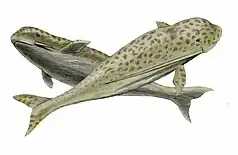| Echovenator Temporal range: Late Oligocene, | |
|---|---|
| Scientific classification | |
| Domain: | Eukaryota |
| Kingdom: | Animalia |
| Phylum: | Chordata |
| Class: | Mammalia |
| Order: | Artiodactyla |
| Infraorder: | Cetacea |
| Family: | †Xenorophidae |
| Genus: | †Echovenator Churchill et al., 2016 |
| Species: | †E. sandersi |
| Binomial name | |
| †Echovenator sandersi Churchill et al., 2016 | |
Echovenator ("echolocation hunter") is a genus of primitive odontocete from late Oligocene (Chattian) marine deposits in South Carolina belonging to Xenorophidae.[1]
Description and paleobiology
Echovenator is distinguishable from other xenorophids in having a paranaris fossa and fused fronto-nasal and maxillo-premaxillary sutures.[2] The earbone structure shows that this odontocete was clearly capable of echolocation.[2]
References
- ↑ Lazaro, Enrico de (2016-08-08). "Echovenator sandersi: Oligocene Whale Had Ultrasonic Hearing | Paleontology | Sci-News.com". Sci.News: Breaking Science News. Retrieved 2023-12-06.
- 1 2 Churchill, M.; Martinez-Caceres, M.; et al. (2016). "The origin of high-frequency hearing in whales". Current Biology. doi:10.1016/j.cub.2016.06.004..
This article is issued from Wikipedia. The text is licensed under Creative Commons - Attribution - Sharealike. Additional terms may apply for the media files.

